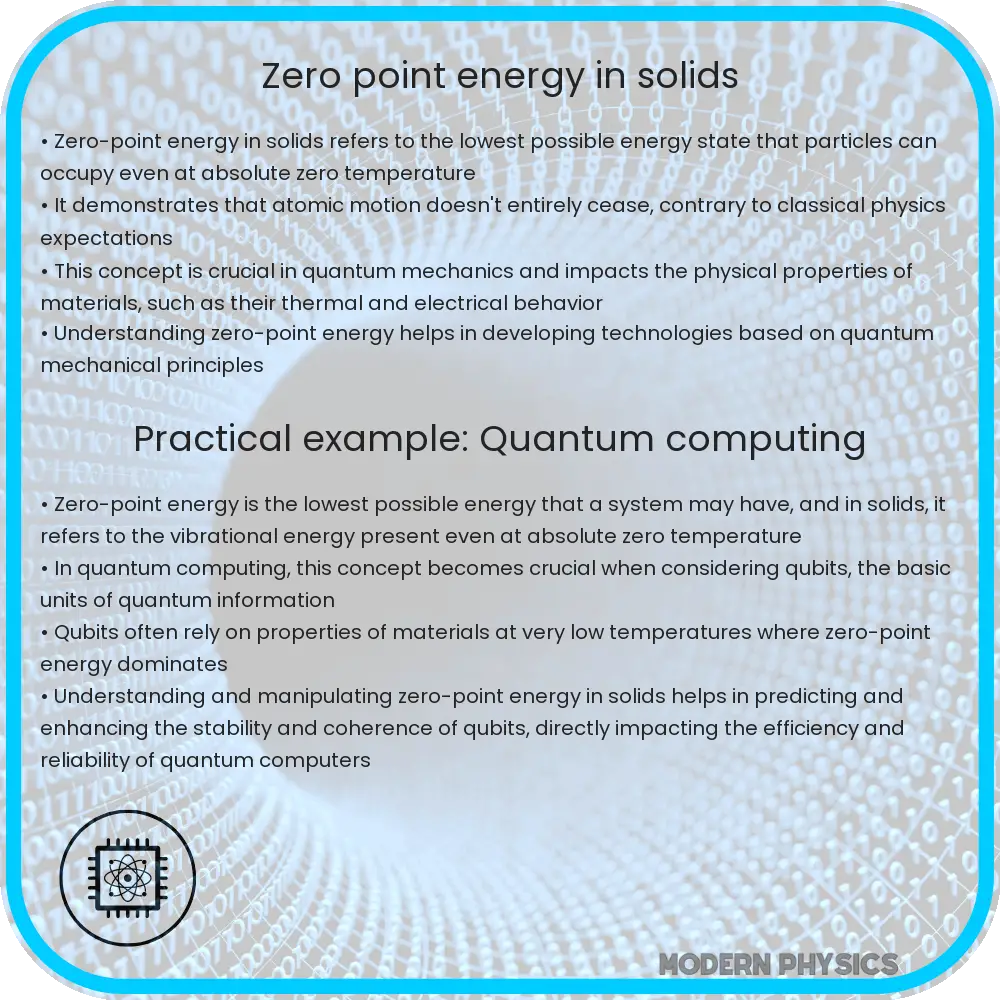Explore zero-point energy in solids, its quantum theory, and applications in superconductivity, quantum computing, and material science for future tech.

Understanding Zero-Point Energy in Solids
Zero-point energy (ZPE) represents the lowest possible energy that a quantum mechanical physical system may have. Unlike in classical mechanics, quantum systems constantly fluctuate in their lowest energy state due to the Heisenberg uncertainty principle. This principle implies that particles, such as electrons in atoms, cannot be at rest even at absolute zero temperature. In the context of solids, zero-point energy plays a crucial role in understanding their quantum mechanical properties and behaviors.
The Quantum Theory of Solids
The quantum theory of solids provides a framework for understanding the electronic and vibrational properties of materials at the quantum level. At this scale, the wave-like nature of particles and the quantization of energy levels become significant. Zero-point energy is particularly important in the study of phonons, which are quantized modes of vibrations within a crystal lattice. These vibrational modes contribute to the zero-point motion of atoms even at the lowest temperatures, affecting the material’s thermal, mechanical, and electrical properties.
Applications and Implications of Zero-Point Energy
- Superconductivity: The phenomenon of superconductivity, where a material conducts electricity without resistance below a certain temperature, is influenced by zero-point energy. Understanding ZPE helps in elucidating the behavior of Cooper pairs, pairs of electrons that move through a lattice without scattering.
- Quantum Computing: Quantum bits or qubits, the fundamental units of quantum computers, rely on the principles of quantum mechanics, including zero-point energy. The stability and coherence of qubits are affected by the zero-point vibrations in the solid-state devices used to construct them.
- Material Science: In material science, zero-point energy is critical for predicting the properties of materials at the quantum level. It aids in the development of new materials with tailored electronic, optical, and thermal properties.
Research into zero-point energy in solids continues to expand our understanding of the quantum world, offering insights into phenomena that classical physics cannot explain. As we delve deeper into the quantum mechanical framework, the applications stemming from zero-point energy are expected to revolutionize technology, energy, and material science.
Recent Research and Future Directions
Recent advancements in quantum physics and materials science have propelled forward our understanding of zero-point energy in solids. Cutting-edge research focuses on manipulating zero-point fluctuations to create more efficient energy systems and quantum devices. For instance, studies on nanoscale materials have revealed that zero-point energy can significantly influence the electronic and mechanical properties of these materials, potentially leading to breakthroughs in nanotechnology and electronics.
Challenges in Harnessing Zero-Point Energy
Despite its promising potential, harnessing zero-point energy for practical applications presents significant challenges. The energy scales involved are extremely small, and isolating zero-point energy effects from other quantum phenomena is complex. Moreover, current technology does not allow for the direct conversion of zero-point energy into usable power forms. However, research in this area remains vibrant, with scientists exploring innovative methods to leverage zero-point energy in quantum computing, sensing, and material design.
Conclusion
The exploration of zero-point energy in solids is a fascinating journey at the intersection of quantum theory, material science, and technology. It challenges our classical notions of energy and matter, offering a deeper understanding of the quantum mechanics that govern the behavior of materials. While practical applications that directly harness zero-point energy are still under development, the concepts and phenomena associated with zero-point fluctuations are paving the way for revolutionary advancements in science and engineering. As research continues to push the boundaries of what is possible, the potential of zero-point energy in transforming our technological landscape remains immense. The future of zero-point energy in solids is not just about understanding the fundamental aspects of quantum mechanics but also about exploring the limitless possibilities it holds for innovation and discovery.
